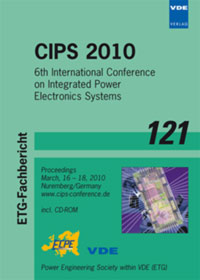Power Semiconductor Joining through Sintering of Silver Nanoparticles: Evaluation of Influence of Parameters Time, Temperature and Pressure on Density, Strength and Reliability
Conference: CIPS 2010 - 6th International Conference on Integrated Power Electronics Systems
03/16/2010 - 03/18/2010 at Nuremberg, Germany
Proceedings: CIPS 2010
Pages: 6Language: englishTyp: PDF
Personal VDE Members are entitled to a 10% discount on this title
Authors:
Knoerr, Matthias; Schletz, Andreas (Fraunhofer Institute for Integrated Systems and Device Technology (IISB), Landgrabenstrasse 94, 90443 Nuernberg, 90443 Nuernberg)
Abstract:
For decades soldering has been the technology of choice in die bonding. However, due to worldwide health regulations, the most common solder alloys, which contain lead, have been banned. Furthermore, standard solders cannot fulfil the reliability requirements of future power electronic devices. New interconnection technologies have to be developed. One of them is pressure sintering of silver flakes, which forms a highly reliable, highly thermally conductive bond. However, the level of pressure needed (30-50 MPa) requires a powerful pressing equipment and can lead to cracking of the devices and ceramic substrates. A promising development is the use of nano-scaled silver particles, which can be sintered using less pressure due to their superior sintering properties. Preceding thermogravimetric and calorimetric analyses showed that the presence of oxygen eases the sintering of silver nanoparticles. In order to grasp the sintering characteristics of interconnection layers consisting of nano-scaled silver, sintering experiments were conducted in both air and nitrogen. Scanning electronic microscope pictures and density measurements with a laser profilometer show that sintering of the nano-scaled silver in air but under a chip, the case of real interest, is closer to uncovered sintering in nitrogen than in air. Densities remain lower and the microstructures more fine-grained. This is due to limitation of diffusion of organics out of and oxygen into the layer. The application of pressure can make up for this in terms of density. Hence, the increase in density of stencil printed layers of nano-silver when sintering at temperatures ranging from 200 to 300deg C, pressures between 0 and 30 MPa, and for a time of up to 1800 s was measured. The density can be set to any value between 60% and 90% of bulk silver by adjusting sintering time and the levels of temperature and pressure. Samples for shear tests were built using dummy chips made of silvercoated copper. They show that after 60 s of sintering at 275deg C and 5 MPa a good shear strength of 40 MPa had been established. If the remaining parameters are set correctly, even 5 s of sintering, a temperature of 225deg C, or a pressure as low as 2 MPa is sufficient to generate bonds comparable to solder and high pressure sinter joints.


